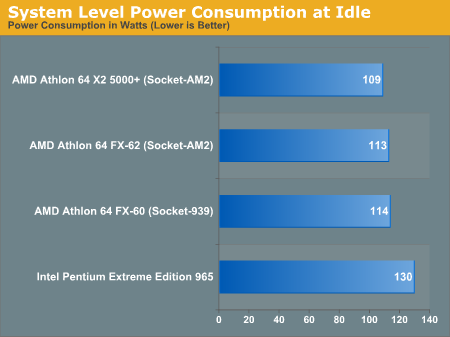AMD Socket-AM2: Same Performance, Faster Memory, Lower Power
by Anand Lal Shimpi on May 23, 2006 12:14 PM EST- Posted in
- CPUs
Power Consumption
Given that AMD reduced power consumption a bit alongside the move to Socket-AM2, we wanted to see how the new chips compared to the latest CPUs AMD had sent us prior to the launch. So we pitted our last Socket-939 sample, the Athlon 64 FX-60, against the two new Socket-AM2 samples we just received: the Athlon 64 FX-62 and the X2 5000+. Remember that the FX-62 actually carries a 125W TDP rating, so it shouldn't be any cooler than previous CPUs, but the X2 5000+ is a new 89W part.
There are inevitably going to be power differences between the Socket-AM2 and Socket-939 motherboards we used, but unfortunately there was no way to isolate them from the comparison as we are measuring total system power consumption.


Under full load, the X2 5000+ does appear to be a bit cooler than the Socket-939 FX-60. We've seen in the past that the 1MB vs. 512KB of cache doesn't really result in any significant difference in power consumption, so it looks like the overall decrease in power consumption is because of the improvements in production AMD has implemented at Fab 30. It is worth noting that the Pentium Extreme Edition 965 consumes just as much power as the FX-62, thanks to its 65nm manufacturing process. Even so, we still can't wait for Intel to drive its power consumption levels even lower later this year.










83 Comments
View All Comments
darkdemyze - Tuesday, May 23, 2006 - link
z-ram isn't due for AMD procs for quite some time, I doubt this is their plan for June..mlittl3 - Tuesday, May 23, 2006 - link
Basically this is what I said above for my guess of the "trick" AMD will use. Anand said it will only affect some high-end users, read FX series so it can't be price cuts as some have suggested (that would effect everyone). Adding L3 cache is the only performance improvement I can think of that doesn't require changing the microarchitecture of the cores (well at least not a big change).However, TDP is still an issue here as someone above suggested. I don't know how much more power it takes to run L3 cache. Last time AMD did it was on K6 and power wasn't really measured back then.
By the way, please ignore Questar's comment below about z-ram being pig slow. I really don't think he knows what he is talking about. /shields eyes from incoming Questar flame
johnsonx - Wednesday, May 24, 2006 - link
K6-III did not have L3 cache. It had L2 cache, making the cache that all socket-7 boards had then an L3 cache.So, let's stop saying things like 'AMD hasn't done L3 cache since K6-III', etc.
mino - Wednesday, May 24, 2006 - link
Well, IMHO the point is AMD has used exclusive 3-level cache structure in the past so they have som experience with thi arrangement.Questar - Tuesday, May 23, 2006 - link
No flame here, look it up for yourself.Z-RAM has high capacitive loading, which results in slow speed.
At 4MB it'll run half the speed of SRAM.
Questar - Tuesday, May 23, 2006 - link
Large amounts of Z-RAM are pig slow.Ecmaster76 - Tuesday, May 23, 2006 - link
Seriously, the one area an Athlon X2 would be bandwidth starved and does it get tested in the preview? NOIn the review? NO
How long ago did we know that the K8 was not bandwidth limited in single application usage? YEARS
So yeah, DDR2 din't increase the 3dMark, big surprise
mlittl3 - Tuesday, May 23, 2006 - link
I think 3dMark06 is multithreaded now so all available cores and bandwidth should be used within the limits of the program. I could be wrong about this however.Ecmaster76 - Tuesday, May 23, 2006 - link
3Dmark06 is almost completely GPU limited. The 3Dmark CPU score did increase a bit, but I really was referring to graphics benchmarks in general.cscpianoman - Tuesday, May 23, 2006 - link
I was just noticing the performance differences between the FX and the EE. In some cases the FX tromps the EE by "gasp" 30%! In other cases the EE makes it's mark. This is part of the reason I am skeptic on Conroe. Yeah it's good. But I always take what Intel, or AMD for that matter, with a grain of salt. Just today we saw the 30% advantage translate down to about 15%. This seems just like any other generation change where 15% is to be expected. The current hype for the Conroe is a product of Intel's excellent marketing dept.